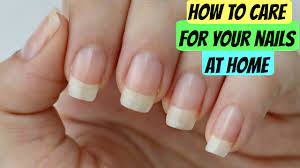As we all do our part to help flatten the curve, nail salon appointments are on hold indefinitely. As a result, you might have some questions about maintaining healthy nails and cuticles right about now—like how to perform an at-home manicure without the mess, or how to remove a gel or dip manicure without damaging your nails. If that’s the case, we’ve got you covered.
Here are some basic tips to help you maintain healthy nails and cuticles right now (and some tips to keep them looking pretty, while you’re at it).
How do I keep my nails and cuticles healthy?
First up, no cutting your cuticles or pushing them back. Keep them moisturized, but otherwise leave them alone.
How to strengthen nails
1. Moisturize your nails
Moisturizing is a well-known secret to healthy skin, but it’s often overlooked in nail care. While dry, brittle nails can be the result of many factors, they’re ultimately a cry for moisture, so consider proper moisture the foundation of your nail care routine. When applying hand lotion, give your nails a little extra attention. There are plenty of moisturizing nail products on the market, but applying moisturizer is really only half the battle—there’s more to strong nails than a fancy cream or serum.
2. Leave your cuticles alone
It’s common practice to cut, push back, or try to get rid of cuticles altogether, but cuticles are not the enemy. In fact, the cuticle is “the nail’s natural protective seal,” Messing with your cuticles can do far more harm than good—even if a nail technician is the one doing the handiwork. A compromised cuticle can leave the nails vulnerable and at risk of infection.
Michele Green, MD, a cosmetic dermatologist, agrees that poorly kept cuticles can have a domino effect. “When your cuticles get dry or injured it can injure the nail bed and affect the way your nails grow out,” Dr. Green says. She recommends moisturizing the cuticles with cream or cuticle oil to help protect and strengthen your nails.
3. Avoid contact with water
Don’t stop washing your hands or shower with gloves on, but do pay attention to ways you can reduce the time your nails spend in contact with water, because excessive water contact can weaken nail structure. (Wet hair is especially vulnerable, and the same caution-when-wet approach you take to handling wet locks can apply to nail care, too.) For example, consider wearing gloves while doing the dishes or other wet work.
You know how soft and bendy nails get after a long bath? Consider this: “The nail is like a sponge. It is 1,000 times more absorptive of water than the skin, for example, and so water can easily diffuse into the nail,” .Excessive water exposure can put significant strain on delicate nail cells (called onychocytes), which can lead to brittleness, peeling, and breakage, she says.
4. Be gentle
The best nail care is gentle care,digging under your nails. “Sometimes people take the pointy end of a nail file and they dig underneath their nails to get the dirt out,” You don’t want to do that, because it can separate the nail plate from the underlying bed, and then you can develop a bacterial fungal infection.”
For similar reasons, you should resist the urge to use your nails as replacement tools—no matter how convenient it may be.
5. Treat your nails like you treat your hair
It’s the new golden rule. Hair and nails are both composed of keratin proteins, so it makes sense that many of the same rules for treatment apply. both hair and nails can become dehydrated and damaged from over-processing. Frequent polish removal, gels, and acrylics do to nails what dyes, chemicals, and heat application do to hair. Just as hydration can help repair hair issues such as frizz and split ends, it can help improve dry and brittle nails. There’s no nail care equivalent to second-day hair, but operating as though there are hard and fast rules for how to wash, care for, and use your nails can help keep them in the same good shape as your hair.






No comments:
Post a Comment